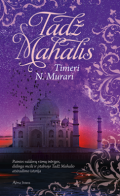 Original language:
English
Original language:
English Translated from: English
Authors: Murari, Timeri N.
Translated by: Žalytė-Steiblienė, Danguolė
Full translated source bibliographical description:
Timeri N. Murari, Taj. A Story of Mughal India, Penguin Books India, New Delhi, 2004
ISBN: 978-609-01-1975-4
Published in: Vilnius
Published on: 2015
Publisher: Alma littera
The first time they meet is in the palace, during Meena Bazaar (a market held for fun in the Great Mughal’s palace during New Year’s festival). They fell in love the moment their eyes met, but they couldn’t be together just yet. 5 years passed from the day they first met to their wedding day. Although they’d only met a few times during those years, their love has never faded away. When they could finally be together, their love only grew bigger. They couldn’t last a day without each other. Arjumand would go to battles with him, even if she was pregnant. She was pregnant 14 times but, sadly, not every child survived. The pregnancies were tiring, so after giving birth to her last baby girl she died in Shah Jahan’s hands.
After death of the empress, Shah Jahan couldn’t think straight. He asked for the best craftsmen in Hindustan and the surrounding countries and ordered them to build the most splendid mausoleum there could be, so that it would reflect the greatness of his deceased love. He wasted gold from the empire’s treasury without second thoughts. He wanted Taj Mahal to be of the best quality, one of a kind. Thousands of people have been building it for over 20 years. A large number of them died, but it’s been finished and it has now become one of the most exceptional buildings in the world, one of its great wonders.
The story isn‘t told from one person‘s point of view. The always changing storyteller gives us opportunity to get to know different characters, understand their way of thinking, analyse everyone and decide, whether they deserve being judged for their actions or not.
The novel also introduces us to 17th century India, its history and culture. The author skilfully portrays the rulers of Mughal dynasty, from Akbar to Aurangzeb, brings out their advantages and flaws without hiding anything and not changing anything too much. He emphasises how righteous Akbar was, how he was always for equality between different religions, and highlighted Aurangzeb‘s cruelty, harshness, his strong belief that there is only one god and disability to acknowledge other religions.
Description of the view takes a huge part of the novel, thus it‘s really easy to paint a picture in your own mind of how luxurious every character‘s clothes look, the splendid view of the palace, the ghostly look of yet-to-be-finished Taj Mahal and the breath-taking view when it‘s completed. The author described jali (a fence around the empress‘s sarcophagus in Taj Mahal) in such detail, that a more skilful painter would be able to replicate it quite accurately on a piece of paper.
Timeri N. Murari (1941) is an Indian writer, journalist, dramaturge and scriptwriter. He‘s been awarded the honourable R. K. Narayan‘s prize in 2002 for his novels and writings for cinema and theatre. „Taj“, which has been translated to almost 30 languages, is what made the author famous. He used to live in Canada, England and the USA, but he‘s come back to his home country India and he lives there up to this day.
